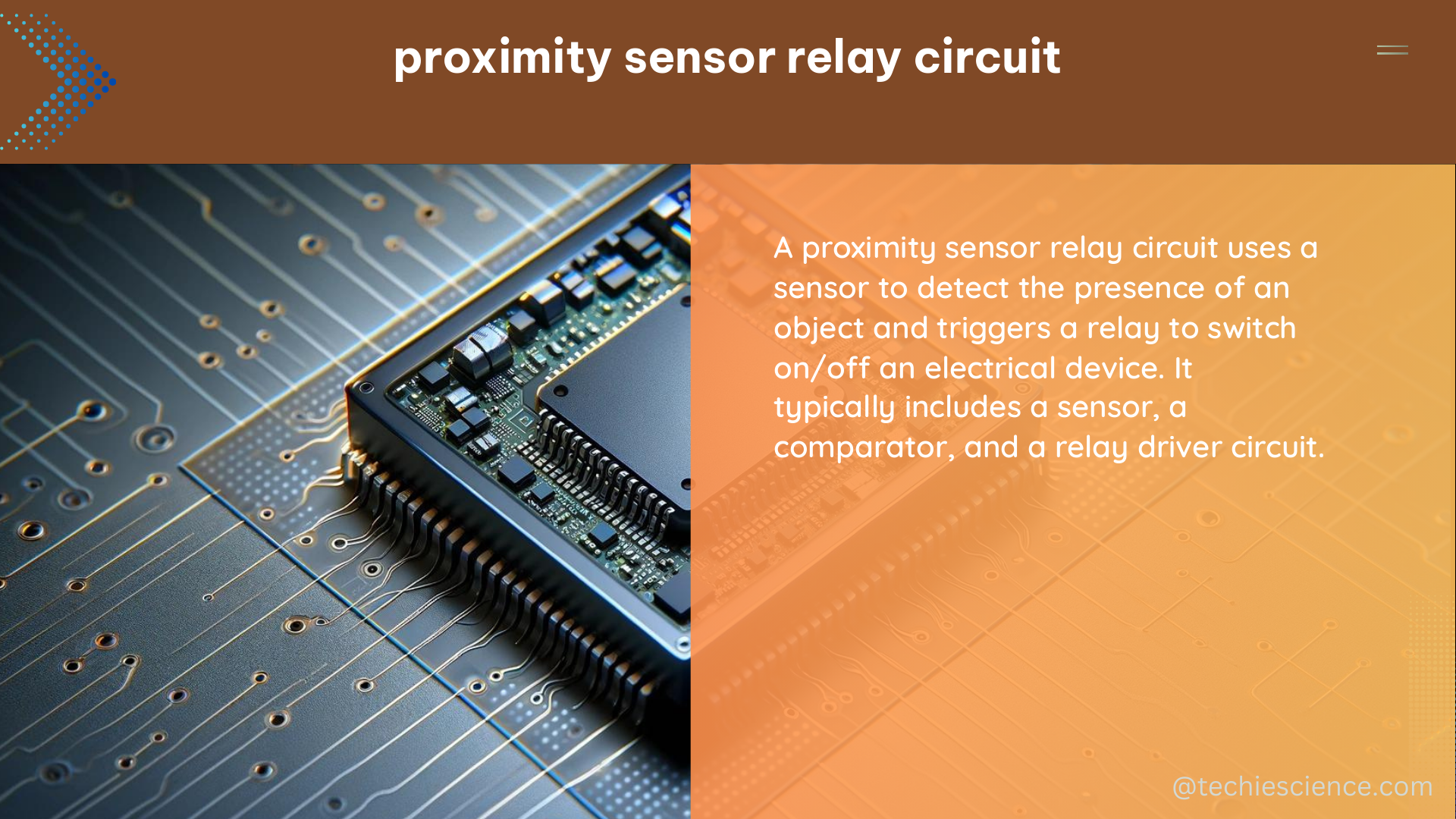The proximity sensor relay circuit is a crucial component in various applications, including industrial automation, robotics, and security systems. It is designed to detect the presence or absence of an object without physical contact, using electromagnetic or ultrasonic waves. This comprehensive guide will delve into the technical specifications, design considerations, and a step-by-step DIY approach to building a reliable proximity sensor relay circuit.
Technical Specifications of Proximity Sensor Relay Circuit
Sensitivity
The sensitivity of a proximity sensor relay circuit refers to its ability to detect objects at a specific distance. It is typically measured in millimeters or inches and can vary depending on the sensor’s type and operating frequency. For instance, an inductive proximity sensor has a typical sensing range of 1 to 80 mm, while a capacitive proximity sensor can detect objects up to several centimeters away. The sensitivity can be adjusted by modifying the sensor’s design, such as the size and shape of the sensing coil or the dielectric material used in a capacitive sensor.
Response Time
Response time is another critical specification of a proximity sensor relay circuit. It refers to the time it takes for the sensor to detect an object and activate the relay. A fast response time is essential in applications where quick detection is necessary, such as in robotics and motion control systems. Typical response times for proximity sensor relay circuits range from a few microseconds to several milliseconds, depending on the sensor technology and circuit design.
Operating Frequency
The operating frequency of a proximity sensor relay circuit is also an important consideration. The frequency of the electromagnetic or ultrasonic waves used in the sensor can affect its sensitivity and response time. Higher frequency waves, such as those used in inductive proximity sensors (typically 100 kHz to 1 MHz), can provide better sensitivity and faster response times but may also be more susceptible to interference from other electronic devices. Lower frequency waves, such as those used in capacitive proximity sensors (typically 1 kHz to 100 kHz), are less prone to interference but may have a lower sensitivity and slower response time.
Circuit Design and Construction
In addition to the technical specifications, the proximity sensor relay circuit’s design and construction are crucial in ensuring reliable operation. The use of high-quality materials and components, such as shielded cables and tamper-resistant enclosures, can help protect the circuit from electromagnetic interference and physical damage. The circuit layout and component placement should be carefully considered to minimize noise and optimize signal transmission.
DIY Approach to Building a Proximity Sensor Relay Circuit

Building a proximity sensor relay circuit from scratch can provide valuable hands-on experience and insights into the design and implementation of this technology. Here’s a step-by-step guide to help you get started:
Components Required
- Proximity sensor (inductive, capacitive, or ultrasonic)
- Relay module (with appropriate voltage and current ratings)
- Microcontroller (such as Arduino or Raspberry Pi)
- Power supply (depending on the circuit’s requirements)
- Resistors, capacitors, and other passive components
- Breadboard or printed circuit board (PCB)
- Wires and connectors
Circuit Design and Assembly
- Sensor Selection: Choose the appropriate proximity sensor based on your application requirements, such as sensing range, object material, and environmental conditions.
- Relay Module Integration: Connect the proximity sensor to the relay module, ensuring that the sensor’s output signal is compatible with the relay’s input requirements.
- Microcontroller Integration: Interface the relay module with a microcontroller, such as an Arduino or Raspberry Pi, to provide control and logic for the proximity sensor relay circuit.
- Power Supply: Determine the power requirements of the circuit and connect the appropriate power supply, ensuring that all components are operating within their specified voltage and current ranges.
- Circuit Layout and Wiring: Carefully plan the circuit layout and wiring to minimize noise, interference, and signal degradation. Use shielded cables and proper grounding techniques to enhance the circuit’s reliability.
- Testing and Calibration: Thoroughly test the proximity sensor relay circuit to ensure that it is functioning as expected. Adjust the sensor’s sensitivity, response time, and other parameters as needed to optimize the circuit’s performance.
Troubleshooting and Optimization
If you encounter any issues during the DIY process, refer to the technical specifications and design considerations mentioned earlier. Utilize online resources, such as forums, tutorials, and manufacturer documentation, to troubleshoot and optimize the proximity sensor relay circuit.
Conclusion
The proximity sensor relay circuit is a versatile and essential component in various applications. By understanding the technical specifications, design considerations, and following a DIY approach, you can gain valuable hands-on experience and create a reliable proximity sensor relay circuit tailored to your specific needs. This comprehensive guide has provided you with the necessary information to embark on your own proximity sensor relay circuit project.
References:
- Sensor Technology Handbook – OLLINTEC
- Digital Habit Evidence – Duke Law Scholarship Repository
- NUREG-1959 “Intrusion Detection Systems and Subsystems
- CONTROL VALVE HANDBOOK – Emerson
- Sensors for daily life: A review – ScienceDirect.com

The lambdageeks.com Core SME Team is a group of experienced subject matter experts from diverse scientific and technical fields including Physics, Chemistry, Technology,Electronics & Electrical Engineering, Automotive, Mechanical Engineering. Our team collaborates to create high-quality, well-researched articles on a wide range of science and technology topics for the lambdageeks.com website.
All Our Senior SME are having more than 7 Years of experience in the respective fields . They are either Working Industry Professionals or assocaited With different Universities. Refer Our Authors Page to get to know About our Core SMEs.